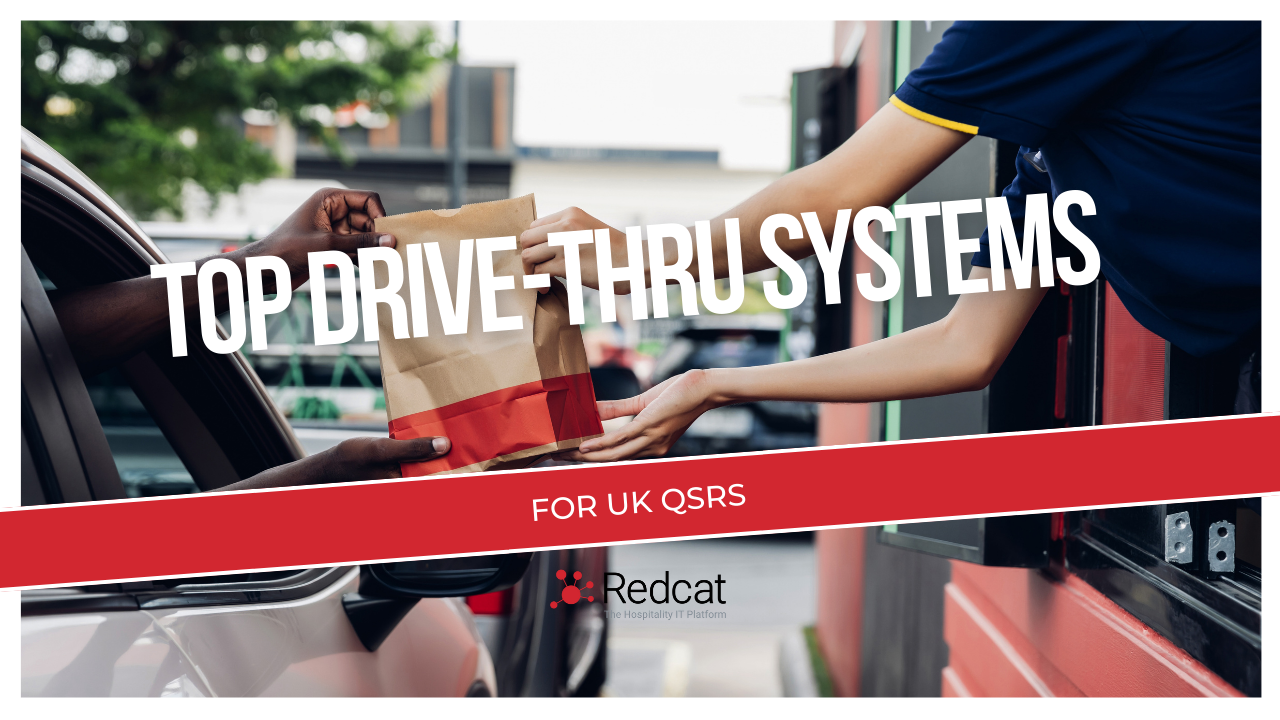5 Ways Redcat Simplifies Drive-Thru Operations for UK Fast Casuals
Introduction In the fast-paced world of fast casual dining, drive-thru operations have become indispensable.
8 min read
Louie Scarpari : Dec 11, 2024 10:50:36 PM

The hospitality industry is undergoing a seismic shift, with Quick Service Restaurants (QSRs) and Fast Casual Diners at the forefront of this tech transformation.
In such fast-paced environments, these businesses cater to customers who expect quick service without compromising on quality. In a sector where every second counts, Artificial Intelligence (AI) is proving to be hugely significant.
AI and advanced hospitality technologies are revolutionising how QSRs and fast casual restaurants operate, delivering unprecedented levels of efficiency, personalisation, and customer satisfaction.
From streamlining day-to-day operations like staffing and inventory management to elevating the customer experience with tailored recommendations and automated ordering, AI is addressing some of the biggest challenges faced by these businesses. Today, hospitality tech like POS systems and loyalty platforms are embracing AI tools.
And of course, with rising competition and developing consumer expectations, QSRs and fast casual diners must embrace innovative tools to stay ahead. AI offers the unique ability to learn, adapt, and optimise processes in real-time, making it a powerful ally in this fast-moving industry.
This article explores the range of ways AI is shaping the future of QSRs and fast casual diners, from improving operational efficiency to driving customer loyalty, and highlights why this technology is needed for modern hospitality businesses.
In the high-pressure environment of QSRs and fast casual diners, operational efficiency is the heart of everything. Every second saved and every resource optimised contributes directly to a smoother operation and better customer satisfaction.
AI is transforming how QSRs manage their internal processes, addressing issues like staffing inefficiencies, inventory waste, and fluctuating demand.
One of the most significant challenges for QSRs is making sure the right number of staff is available at the right time. AI-driven scheduling tools analyse historical sales data, seasonal trends, and even local events to predict customer traffic so you can optimise staffing levels accordingly.
AI powered tools like these reduce the risk of overstaffing during slow periods or being shorthanded during busy times. For example, an AI tool might predict increased foot traffic during a sports event in the area and automatically schedule additional staff for the drive-thru and kitchen.
AI scheduling systems also improve employee satisfaction. As by offering predictive analytics on peak shifts and incorporating employee preferences, these systems create fairer schedules, helping reduce burnout and turnover.
As with most restaurant types, managing inventory is a constant balancing act for QSRs, where running out of a key ingredient can lead to customer dissatisfaction, and overstocking results in waste and higher costs. AI solutions streamline this process by using data from past sales, supplier lead times, and even weather forecasts to predict inventory needs with incredible accuracy.
For example, AI might identify that iced drinks sell more during a heatwave and suggest ordering extra stock of specific ingredients. Similarly, it can flag slow-moving inventory and recommend promotions to clear out excess stock before it expires.
On the supply chain side, AI enables real-time tracking and coordination with suppliers, reducing delays and ensuring that fresh, high-quality ingredients are always available.
AI also supports operational efficiency through predictive maintenance of equipment. Downtime for essential appliances like fryers, grills, or refrigeration units can disrupt operations and lead to lost revenue.
AI systems monitor equipment usage and performance, predicting potential failures before they happen. With this, downtime is reduced and you can maintain a seamless operations.
Personalisation is no longer just a bonus in the QSR and fast food restaurant world, it’s a necessity. AI allows restaurants to tailor experiences for individual customers, boosting satisfaction, loyalty, and repeat visits. Relevant and useful data informs real-time decisions, and AI transforms how customers interact with QSRs.
The key benefits of personalisation for QSRs can be summed up as follows:
AI-driven personalisation is changing the game for QSRs and fast casual diners by making every interaction with the brand feel seamless and meaningful.
Customers enjoy more relevant choices and efficient service, while restaurants gain higher loyalty and revenue, creating a win-win scenario.
Speed is a non-negotiable for QSRs. and AI-powered automation is redefining service efficiency, enabling faster food preparation, streamlined order management, and optimised delivery. These advancements help restaurants handle high volumes of customers while maintaining service quality and consistency.
AI is revolutionising kitchen operations by automating repetitive and time-sensitive tasks. Robots and AI-enabled kitchen systems can cook, fry, or assemble meals at speeds far beyond human capability.
When you automate routine tasks, these technologies free up staff to focus on more complex aspects of food preparation, improving both speed and everyday operational efficiency.
AI also makes order management better, from placement to delivery. In drive-thrus, voice recognition technology processes orders quickly and accurately, minimising delays caused by human error. AI cameras and sensors detect approaching vehicles and prioritise orders, ensuring the fastest possible turnaround.
By integrating AI into these processes, QSRs can fulfil more orders during busy periods without compromising service quality.
Queue management, as you probably already know, is incredibly important for fast-paced environments. AI tools predict busy periods by analysing historical sales data and customer trends.
AI-powered automation benefits both customers and restaurant operators. Faster service times mean less waiting, leading to better customer experiences and higher satisfaction rates.
Financially, QSRs benefit from increased order throughput during peak times and reduced operational costs through smarter resource allocation.
By balancing technology and human interaction, AI-driven automation allows QSRs and fast casual diners to excel in speed, accuracy, and efficiency. This combination not only meets the high expectations of modern customers but also positions these businesses as leaders in the ever-competitive food service industry.
Customer satisfaction and loyalty are essential for QSRs and fast casual diners, where keeping existing customers is more cost-effective than attracting new ones. AI is transforming how these businesses engage their patrons by improving feedback resolution, creating dynamic loyalty programs, and personalising the overall dining experience.
AI-powered tools collect and process customer feedback in real time, giving restaurants the tools to address issues before they escalate. For example, sentiment analysis systems scan reviews, surveys, and social media posts to detect trends, such as complaints about slow service or missing items.
AI immediately alerts managers to take action when necessary, such as reallocating staff during busy times or offering real-time apologies. Automated responses, like discounts or loyalty points for dissatisfied customers, turn negative experiences into opportunities to strengthen trust.
Dynamic loyalty programs, boosted by AI, provide rewards tailored to individual customers:
Targeted incentives encourage repeat visits and create stronger connections between customers and your brand.
AI also transforms the dining experience by personalising interactions. Intelligent systems adapt menus to highlight options that match a customer’s preferences or dietary needs. At kiosks or through apps, AI recommends pairings, like a dessert with a meal, improving satisfaction and boosting average order values.
Long-term loyalty grows through AI’s predictive capabilities, such as personalised birthday rewards or reminders for seasonal favourites. VIP perks for frequent customers, like exclusive discounts or early access to promotions, further solidify loyalty.
AI is a powerful tool for QSRs and fast casual diners looking to reduce costs and increase overall profitability. By optimising key areas such as energy use, inventory management, and fraud prevention, AI enables your business to operate more efficiently while maximising your bottom line.
One significant way AI reduces costs is through energy efficiency. Smart systems powered by AI monitor and regulate energy usage in real-time, ensuring equipment like refrigerators, ovens, and HVAC systems run optimally.
For instance, AI can adjust heating or cooling systems based on peak hours, reducing unnecessary energy consumption during quieter periods. Over time, these small adjustments can result in substantial savings on utility bills.
Another cost-saving application is inventory management. AI tools analyse sales trends, seasonal patterns, and supplier lead times to predict inventory needs with precision. This minimises food waste by preventing over-ordering while reducing the risk of running out of high-demand items.
For example, during hot weather, AI might forecast increased demand for iced drinks and automatically adjust supply orders accordingly.
AI also aids in fraud detection and loss prevention. By monitoring transactional data, AI systems can flag suspicious activities, such as voided transactions or unusual discount patterns, helping managers identify and address potential theft or errors.
Finally, AI-driven automation lowers labour costs by streamlining repetitive tasks, such as order processing or kitchen preparation, allowing staff to focus on higher-value activities like customer service.
The future of QSRs and fast casual dining is being shaped by innovative AI technologies that go beyond current capabilities, positioning these businesses to meet evolving customer demands and operational challenges. From advanced delivery systems to sustainable operations, AI trends keep revolutionising the industry.
AI integration with emerging technologies is redefining convenience. Voice AI is gaining traction in mobile apps and drive-thrus, enabling customers to place orders faster and more accurately through natural language processing. For example, voice assistants can remember frequent orders or suggest items based on dietary preferences, improving the user experience.
Delivery systems are also constantly developing. AI-powered delivery drones and autonomous vehicles are being tested to streamline the last-mile process, allowing for faster, more cost-effective order fulfilment. These innovations not only improve delivery times but also reduce labour costs, offering a glimpse into how QSRs may operate in the near future.
As sustainability becomes a priority, AI is helping QSRs optimise eco-friendly practices. By analysing data across the supply chain, AI identifies inefficiencies, such as excess packaging or energy-intensive processes, and suggests greener alternatives. Predictive tools can also help restaurants reduce food waste by forecasting demand more accurately, ensuring perishable items are used effectively.
The growing reliance on AI underscores the importance of data. Real-time data collection and analysis allow businesses to adapt quickly to changing consumer trends, such as the rising demand for plant-based or health-conscious options. Of course, ethical data use and compliance with privacy regulations will be highly important as AI adoption expands.
AI is undeniably revolutionising the QSR and fast casual dining industries, offering solutions that enhance efficiency, elevate customer experiences, and drive profitability.
From automating kitchen operations to personalising interactions and reducing waste, AI empowers restaurants to meet the demands of today’s fast-paced, tech-savvy consumers. As emerging trends like voice AI, autonomous delivery, and sustainability-focused innovations gain momentum, these technologies will continue to shape the future of dining.
At Redcat, we make sure we’re always ahead of the curve in hospitality tech. Our full platform covers everything from POS systems to self-serving kiosks. Reach out today to book your demo.

Introduction In the fast-paced world of fast casual dining, drive-thru operations have become indispensable.

In today’s fast-paced world, convenience is paramount—and nothing epitomises convenience better than a drive-thru. For Quick Service Restaurants...

The Growing Importance of Drive-Thru Technology in UK QSRs